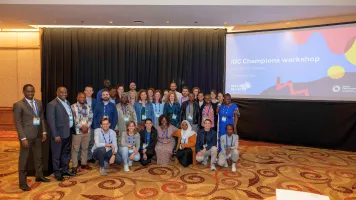This piece is part of a Global Disability Summit blog series from Inclusive Data Charter Champions.
People with disabilities have been historically excluded and discriminated against in multiple areas of society, from the labor market to the health system and political sphere. This exclusion has been mirrored with an invisibility in data and official statistics.
In Colombia, the National Administrative Department of Statistics (DANE, the acronym in Spanish) has been working to progress the collection and use of official statistics on persons with disabilities for several years. This process has not always been straightforward. We want to be transparent about the learnings and challenges we face in generating quality data to accurately reflect the situation of persons with disabilities.
Devising questions to gather globally comparable disability data
To address the global scarcity of disability data, The Washington Group on Disability Statistics (WG) was created in 2001. The WG set out to establish global guidelines that help national statistical offices and institutions collect and analyze data on persons with disabilities.
The WG created a short set of questions that assess whether persons with disabilities participate in activities such as employment, education, and family life to the same extent as persons without disabilities.
The developments made by the WG are anchored in a vision of disability that transcends a medical perspective, instead adopting a biopsychosocial model—conceiving of disability as an interaction between people and the context in which they live. In other words, disability is understood as the interaction between two elements:
- A person’s capabilities (limitations in functioning)
- Environmental barriers (physical, social, cultural or legislative) that prevent their full participation in society.
Challenges in generating disability data in Colombia
DANE has adopted the WG guidelines in several of its ongoing statistical operations. However, we have faced challenges with mainstreaming this approach across our statistical operations.
DANE is currently updating the sampling frames—the source data from which samples are drawn from—to align with the most recent national housing and population census (2018). This process has led to challenges around the comparability of figures on the number of persons with disabilities in Colombia over time. The following table shows the versions of the short set questions and the results obtained for each period, compared to the original WG guidelines.

Variations among questions are due to shifts in operational needs and an open participatory process. For the 2018 National Housing and Population Census (NHPC), there was a participatory process involving civil society organizations and health authorities to adopt the guidelines of the WG and then adapt them to the Colombian context. As an outcome of this participatory process, the following changes were made:
- An additional question was added: “Carry daily activities without presenting cardiac or respiratory problems?"
- Short and simple phrases were adopted for each of the activities
- Eliminating the support mechanisms of the options that included them. For the questionnaires used since 2021, following the WG’s guidelines, options with the supporting mechanism were included.
Additionally, after the 2016 census pilot, we discovered that adding the short set of questions recommended by the WG increased the time it takes to complete the census. In response, a filter question was added at the beginning of the questionnaire. The WG questions were only asked if the respondent answered ‘yes’ to this question: Given your physical and mental condition, and without any kind of help. . . In your daily life do you have difficulties in performing activities such as: hearing, speaking, seeing, moving your body, walking, grasping objects with your hands, understanding, learning or remembering, eating or dressing yourself, and interacting with others?
The WG questions were also included in the Quality of Life Survey from 2018. This survey has one of the highest sampling powers in Colombia—meaning it is able to provide a more detailed picture—and is representative at the local levels of ‘departmentos.’ After the census, this survey updated its sampling frame in 2020 (previously DANE worked with the sampling frame of the previous census in 2005).
Taking these differences into account, the range of population with disabilities varies across the surveys and census. For example, according to the NHPC of 2018, 4.1% of the Colombian population (1.78 million people) had disabilities. According to the Quality of Life Surveys performed in 2018 and 2019, this figure was 7.7% (3.5 million people), but the 2020 Quality of Life Surveys found that the number had decreased to 5.7% (2.7 million people).
Prioritizing transparency and collaboration going forward
As a national statistical office, it is important to underscore our commitment to produce a unified figure of the number of persons with disabilities in our country. We must recognize and provide solutions to methodological challenges which emerge as we progress more inclusive statistical processes.
As we evolve DANE’s approaches, we recognize that it is critical to cooperate and collaborate with others to build a more sensitive measurement tool that produces, at regular points in time, a unified figure of people with disabilities and generates data which accurately reflects their reality and situation.
To advance our efforts on disability inclusion, we have included the WG questions in other surveys to continue monitoring the results and we are preparing a detailed statistical note to transparently explain these methodological differences and results in more depth. The statistical note goes beyond presenting the number of people with disabilities in Colombia, analyzing their socioeconomic situations in 2020. It will be launched in the coming weeks.


